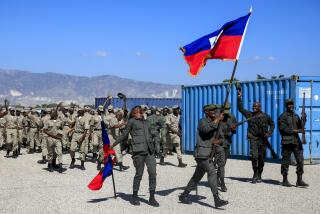U.S. Not Sure How Haiti Deal Will Work : Strategy: Detailed planning didn’t envision army remaining intact.
WASHINGTON — In the clear light of a morning after, Clinton Administration officials took a second look Monday at their hastily negotiated deal with Haiti’s ruling generals, contemplated its flaws--and decided that they could live with it.
Administration officials acknowledged that the pact wasn’t perfect.
They said its unexpected outcome--a peaceful entry for 15,000 U.S. troops, but with the brutal military regime still in place--threw their detailed plans for Haiti into confusion.
“We did not have a plan specifically for this contingency,” confessed an official who was at President Clinton’s side in the Oval Office during the weekend-long negotiations. “We don’t know exactly how this is going to work.”
Even former President Jimmy Carter, who ground out the agreement in more than 20 hours of negotiations over two wearying days, said the one-page pact might have some weak spots. “I don’t want it to be examined in the most minute detail by lawyers,” he said.
What is worrying some American officials and critics outside the Administration, however, isn’t a matter of technical glitches but of where the strange, hybrid result of the weekend’s negotiations may lead.
Among the deal’s potential problems: It contains no requirement that Haiti’s top two military rulers, Lt. Gen. Raoul Cedras and Brig. Gen. Philippe Biamby, leave the country--merely that they retire by Oct. 15.
Cedras has said he wants to stay in Haiti and run for president, though some of his friends in Port-au-Prince said Monday they expect him to leave.
The pact includes no provision for disarming or demobilizing most of Haiti’s armed forces, as U.S. policy has sought. Indeed, it doesn’t formally bind other officers and their units to the leadership’s commitments, “so there might very well be violations,” Carter noted.
Most important for Haiti’s future, the agreement implies that the existing structure of Haiti’s armed forces, long the country’s main instrument of repression, should be maintained.
“We have preserved the Haitian armed forces at the moment,” acknowledged Gen. Colin L. Powell, the former chairman of the Joint Chiefs of Staff and one of the U.S. negotiators.
And, on the ground, the pragmatic demands of moving 15,000 troops peacefully into Haiti already seem to have driven the American expeditionary force, willingly or not, into the arms of Cedras and his high command.
Lt. Gen. Hugh Shelton, the U.S. commander in Haiti, told reporters in Port-au-Prince that he had found Cedras highly cooperative and would even rely on the Haitian army to help maintain order. Cedras “will use his forces in some cases to make sure that there is no violence, if you will, displayed either against his own forces or against ours,” Shelton said.
That prospect drew anguished complaints from U.S. supporters of exiled Haitian President Jean-Bertrand Aristide--and even from Senate Minority Leader Bob Dole (R-Kan.), who is not an Aristide admirer.
Dole said he didn’t understand why Cedras was “allowed to stick around until the 15th of October, maybe stay in the country and maybe run for president next year.”
Sen. Tom Harkin (D-Iowa) said the Administration had “folded.”
“Before, we were going to go in on the side of the Haitian people,” he said. “Now, we’re going in on the side of the Haitian military.”
Rep. Lee H. Hamilton (D-Ind.), chairman of the House Foreign Affairs Committee, said he considered the U.S.-Haitian military cooperation one of several “imperfections” in the deal.
Randall Robinson, head of TransAfrica, an African American lobbying group, said the arrangement was “impractical folly,” comparing it to allowing Nazi war criminals to remain in positions of power at the end of World War II. “This will be a very combustible situation,” he said.
George Vickers, head of the Washington Office on Latin America, a liberal lobbying group, complained: “The transition process is in the hands of the Haitian military.” As a result, he said, even if Aristide returns to Haiti next month, it could “only represent a democratic facade without eliminating the structures responsible for the coup.”
The outcome of the talks also left U.S. officials scrambling to figure out what their forces on the ground should do, and when.
They said their earlier plans had always assumed that the command structure of the Haitian armed forces would collapse as a result of a U.S. invasion or because its leaders would flee into exile.
With Cedras and his colleagues still in place, officials were unable to say when or how they would begin the most important parts of their mission: disarming the paramilitary thugs who have terrorized Haiti’s poor, reorganizing the police force and, eventually, remaking the army.
Asked when multinational troops intended to retrain the police will arrive, for example, State Department spokesman Michael McCurry could only reply: “That is an operational detail.”
Another senior official acknowledged: “I don’t know, and nobody knows.”
On Sunday night, immediately after Clinton announced the Haitian deal, senior officials from half a dozen government agencies held a hastily convened telephone meeting to begin revamping their plans, he said.
Similar meetings were still under way, almost nonstop, on Monday.
More to Read
Sign up for Essential California
The most important California stories and recommendations in your inbox every morning.
You may occasionally receive promotional content from the Los Angeles Times.











